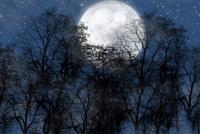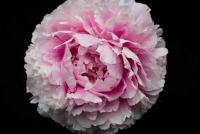The use of barberry in landscape design: planting and care
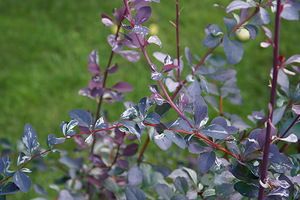
This magnificent, purple barberry is transformed with the appearance of young shoots with delightful variegated leaves, covered with numerous white and pink splashes!
The diameter of the crown of an adult plant: 1.5 m
Height of an adult plant: 1.7 m
Description
Spiny sprawling purple shrub with magnificent variegated young leaves, blooming on young shoots, very refreshing dark color of the whole plant. Harlequin is very similar to the barberry tunberg, but a bit larger and brighter than it. The flowers are tender, yellow inside, reddish outside, small red fruits stay on the bushes for a very long time, decorating the plant after the leaves fall. Winter hardy, frost hardy. Prefers a sunny location. It is not demanding of soils, it can grow on soils of any acidity, does not like only stagnant moisture. Disease and pest damage is weak.
The form
Wide, sprawling
Needles / Foliage
Small, young on annual growths with white and pink stripes and spots on a purple background, mature - purple
Bloom
The flowers are small, yellow with a reddish tinge, the fruits are bright red, long stay on the bushes
Requirements
It prefers sunny places, it is resistant to bright sun, but we tolerate partial shading. The soil is not demanding, it grows on any well-drained soils, but does not tolerate stagnant moisture. Frost resistant Disease and pest damage is weak.
Landing guide
Planted in open areas or in partial shade on sunny, warm, sheltered places and drained soils. Plant in a mixture: turf ground, humus, sand - 1: 1: 1. The optimum acidity is pH 6.0 - 7.5. When planting in acidic soil, liming is necessary: 300-400 g of hydrated lime on a bush. Plants with decorative leaf color lose their color when planted in the shade. Root neck at ground level.
Care guide
Requires pruning undeveloped shoots. Old bushes thin out in spring. When arranging hedges, pruning is carried out in the second year after planting, cutting from 1/2 to 2/3 of the above-ground part. In subsequent years, pruning is carried out 2 times a year: in the first half of June and in early August. It is recommended to carry out periodic anti-aging pruning on the stump to maintain the crown in a decorative state.
It is used as a tapeworm on the lawn, in private and group plantings, as a color accent in tree-shrub compositions, in cropped and free-growing hedges, borders, in mixed with perennial groups.
Barberry - a fairly common shrub. Its widespread use in landscape design due to the presence of a large number of varieties, due to which effective compositions are created. It is also necessary to look for a plant with so many forms and colors that the barberry has. Photos of the species will be presented below.
Barberry is a vast genus of deciduous or evergreen shrubs and, sometimes, trees. The leaves of representatives of this genus are collected in small bunches and can be of various shapes: oval, ovate, lanceolate, and dentate along the edge. The colors depend on the type and variety, here you can find the most amazing color options. Part of the leaves of this shrub turned into spines, which in some species reach several centimeters in length.
The barberry blossoms at the end of spring, with golden flowers with a strong aroma, which are collected in buds and completely cover the whole bush. Fruits, which can be red or black, appear in August-September and add decorativeness to the shrub. In addition, they contain many useful substances. Previously, the fruits and leaves of barberry were used as medicine, and in our time - this is a common seasoning and additive to tea.

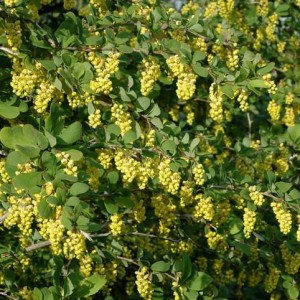

That's what the barberry is - in all respects a useful plant.
Types and varieties
In landscape design uses several types of barberry: Amur, ordinary, Ottawa and Thunberg. On their basis, created numerous varieties that allow to decorate any area. Photo barberry and its varieties - in this section.
Barberry Thunberg - A low, strongly branched plant (maximum height - 1.5 meters), originally from Japan. The leaves are oval or oblong, the spines are small and thin, and the fruits appear at the beginning of autumn, but they are not suitable for food. One of the important features of this species is slow growth. Winter hardiness of barberry Thunberg is average. So, popular varieties:
- "Aurea" - compact bush up to a meter in height, forming a spherical crown. Leaf color in summer varies from light green to golden yellow and turns yellow to orange in autumn.
- Green Carpet - sprawling bush with drooping shoots and hemispherical crown. The whole warm season, this species is covered with leaves of a light green color, which in the fall acquire a carmine-red color.
- "Harlequin" - A plant with a height of up to one and a half meters with arc-shaped shoots. The leaves of this variety are red with white or pinkish spots.
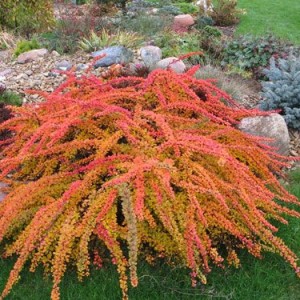 Barberry Thunberg "Green Carpet"
Barberry Thunberg "Green Carpet" 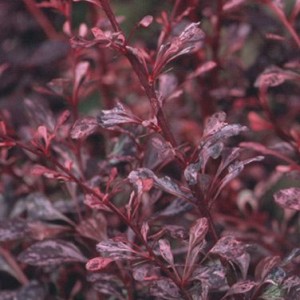 Barberry Thunberg "Harlequin"
Barberry Thunberg "Harlequin"
- Rose Glow - loose shrub up to one and a half meters and straight shoots. The color depends on the age of the leaves, so the young leaves are covered with a marble pattern of pink or bronze tones, and the old leaves are purple.
- Golden Ring - large barberry. The plant is up to 3 m tall, with purple, bordered at the edges with yellow leaves. In the autumn the bush transforms - its foliage turns bright red.
- Atropurpurea - a plant reaching a height of 1.5 meters, and its variety "Nana" - up to half a meter. The leaves of the “giant” are brown-red all season, and the dwarf form in autumn changes its color to red.
 Barberry Thunberg "Rose Glow"
Barberry Thunberg "Rose Glow" 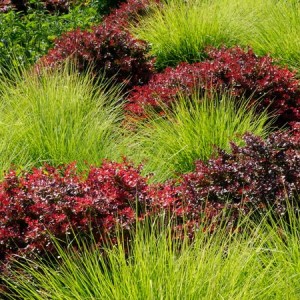 Barberry Thunberg "Atropurpurea"
Barberry Thunberg "Atropurpurea"
- "Bagatelle" - A miniature bush that does not grow more than 40 cm in height. Its leaves are brownish in summer, and turn red in autumn. Unlike other varieties of Thunberg, the fruits of this are edible.
Common barberry - shrub (photo of which can be seen below) up to 2.5–3 m high, with numerous shoots and oval leaves of dark green color, which in the autumn turns into purple or bronze. This species belongs to the fast-growing, and can also form dense root shoots. Easily tolerates a haircut.
Barberry of Ottawaoriginally from Canada, strongly reminiscent of Barberry Thunberg, but much larger than him. A distinctive feature is a small number of spines. Canadian shrub varieties:
- "Auricom" - a plant up to 2 m high, with oval leaves, large for a barberry. Their color in summer is red, and in autumn it turns into orange.
- "Superba" - also differs in large leaves, but their coloring is less bright due to the gray raid.
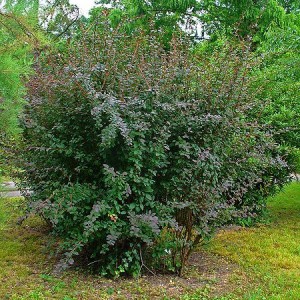 Barberry ordinary
Barberry ordinary 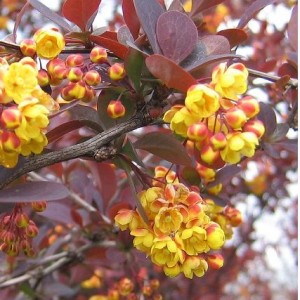 Barberry Ottawa "Superba"
Barberry Ottawa "Superba"
Barberry Amur It comes from the Far East, it is distinguished by its good frost resistance. This is a tall shrub with a few shoots that are densely covered with small oval leaves. The color of the leaves is usually bright green, but there are forms with burgundy color. The spines of this species are threefold, and the fruits it gives are inedible.
Planting and care
Barberries can grow on any soil, if only one important condition is met: in natural places where the barberry grows, groundwater lies deep, so they should not be close to the surface on the site either. Also, these shrubs are not planted:
- In the lowlands.
- In shady places. When shading, the brightness of the color, and accordingly the decorative effect, decreases.
- In open spaces with cold winds (this is especially true for the barberry Thunberg).
Planting is usually done in early spring, before bud break, but even in the case of planting in September, the plant has time to take root. If the seedling is closed root systemthen you can land at any time of the year.
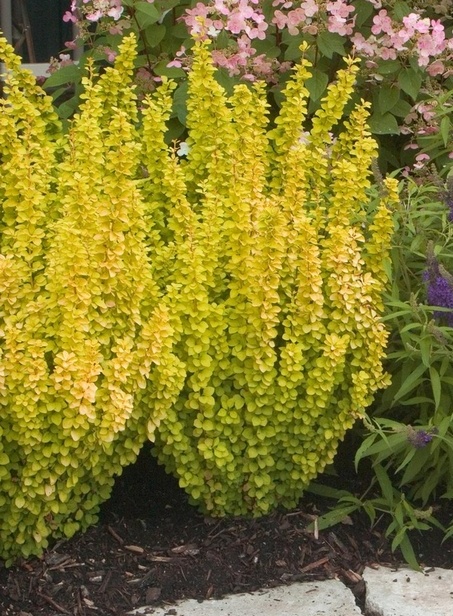 A landing pit or trench, in the case of a hedge, is prepared in advance, its dimensions must exceed the dimensions of the seedling root system. The bottom is usually laid out drainage of gravel or broken brick. Garden soil is suitable as a soil mix, in which you can add a little mineral fertilizer.
A landing pit or trench, in the case of a hedge, is prepared in advance, its dimensions must exceed the dimensions of the seedling root system. The bottom is usually laid out drainage of gravel or broken brick. Garden soil is suitable as a soil mix, in which you can add a little mineral fertilizer.
The barberry shrubs are best transplanted with the preservation of the earthy coma, without deepening the root neck. After planting, the soil is poured abundantly with water and the barrel circle is mulched.
Care for the barberry is in periodic watering (more frequent in the first year after planting), dressing and cutting.
Adult bushes are watered only during long droughts, and fertilizing is carried out several times per season: in the spring they make nitrogen and potash fertilizers, and closer to autumn - phosphate fertilizers.
The plant can suffer from severe frosts, so in the spring they carry out sanitary cutting, removing dead branches.
Shelter for the winter is required only to the barberry Thunberg. Laptrum or non-woven material is suitable for this purpose.
Planting a barberry and caring for it do not pose any particular difficulties even for an inexperienced gardener.
Diseases and pests of barberry
The minus of the barberry is its tendency to powdery mildew. Most often this occurs in rainy summer. The leaves are covered with white spots, on which droplets of liquid are sometimes noticeable. The way to combat this disease is to treat the plantations with fungicides.
There are also spotting and rust of leaves (Amur barberry is practically not exposed to them). The methods of struggle are the same as for powdery mildew.
The simplest and most effective method of breeding barberry is grafting. The cuttings are harvested in spring from annual shoots, cutting off twigs at an angle of 45⁰. They are planted in a wet peat-sand mixture, immersed in the substrate for a few centimeters. It is important to maintain moderate soil moisture. By the end of the season, the cuttings have a root system and can be planted in a permanent place.
Reproduction is practiced by dividing the bush. Adult plants with a large number of shoots are suitable for this. They dig up the bush and divide it so that shoots and roots remain on each delenka, cuts are processed with crushed coal and planted in permanent places.
Seed propagation is a long process and is not used in the case of varietal plants.
Barberries in landscape design
Due to the variety of varieties, the barberry can be used in various compositions: these are group plantings on the lawn, and various mixborders, and multi-tiered plantations. On alpine hills and gardens, dwarf varieties look great. Good bright bush and as a solo plant. Hedges and borders from this thorny shrub have become quite widespread, but this is not surprising - after all, barberry barrels do not become bare over time and the fence always has a decorative appearance.
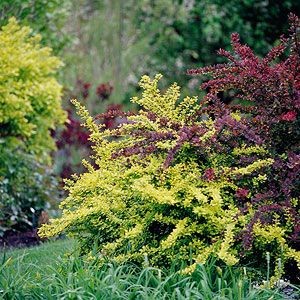



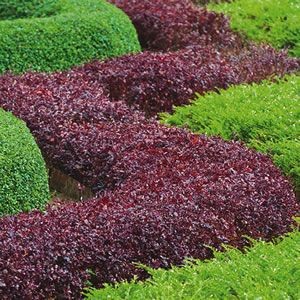

To create a hedge fit tall varieties of barberry Turnberg, as well as barberries ordinary and Ottawa, and dwarf varieties with a dense crown - a good material for a low border.
Plants are planted for hedging in a staggered manner so that no more than four seedlings per meter are obtained (this is especially important for the ordinary barberry, which grows very quickly). In the first years after planting such a hedge, a haircut is not needed, but then it is necessary to give shape to the green fence.
Barberry Thunberg "Rose Glow"
(Berberis thunbergii "Rose Glow")
A prickly, spreading, purple shrub with magnificent variegated young leaves, blooming on young shoots, very refreshing dark color of the whole plant. The diameter of the crown and height reaches 1.5 m in height. The leaves are pink-red or crimson with pink stains, motley, in autumn - orange color. Annual growth of about 15 cm.
Terms of flowering and fruit ripening
The flowers are tender, yellow inside, reddish outside, small red fruits stay on the bushes for a very long time, decorating the plant after the leaves fall.
Optimal conditions growing
It is not exacting to soil conditions, prefers soils with neutral reaction, does not tolerate stagnant overwetting, near groundwater. It prefers sunny places, it is resistant to bright sun, but we tolerate partial shading. Winter hardy, frost hardy. Disease and pest damage is weak. Requires pruning undeveloped shoots. Old bushes thin out in spring. When arranging hedges, pruning is carried out in the second year after planting, cutting from 1/2 to 2/3 of the above-ground part. In subsequent years, pruning is carried out 2 times a year: in the first half of June and in early August. It is recommended to carry out periodic anti-aging pruning on the stump to maintain the crown in a decorative state. Well tolerated haircut and shaping.
Methods of reproduction and planting rules
Propagated by dividing the bush, root suckers, summer cuttings and seeds. The easiest way to seed and grafting. Before sowing, the seeds must be stratified: fresh seeds fall asleep in a nylon sack and placed in wet moss or sawdust, stored at a temperature of 3-5 ° until April - May, then sown in a greenhouse or bed. Also, seeds can be sown in the fall to a depth of two - three centimeters. Nitrogen fertilizers are applied in the spring, then fertilized once every 3 to 4 years. It is necessary to make complex fertilizers with micronutrients.
Application
It is used as a tapeworm on the lawn, in private and group plantings, as a color accent in tree-shrub compositions, in cropped and free-growing hedges, borders, in mixed with perennial groups.
|
|
Something to me today was a little sad. They pour cold rains, and only occasionally make the rays of the summer sun through dark clouds hanging over the forest. Even fire arrows of lightning do not wish to add the colors of summer to gray July. Looking through the photos in the phone, unexpectedly opened the bush-feast for itself; a summer holiday, a spring holiday, an autumn holiday, a winter holiday, a holiday for birds, a holiday for bumblebees and a holiday for us. He, like a firework, explodes above the ground a fountain of multi-colored leaves. Imagine a small photo gallery with the image of barberry. When I took pictures, I didn’t even think about the fact that today these pictures will lift my spirits. I already smile and sincerely hope that I can give you a good mood and to you.
The pink fountain exudes light -
Barberry is dressed in a festive attire.
Looks festive at any time of the day. 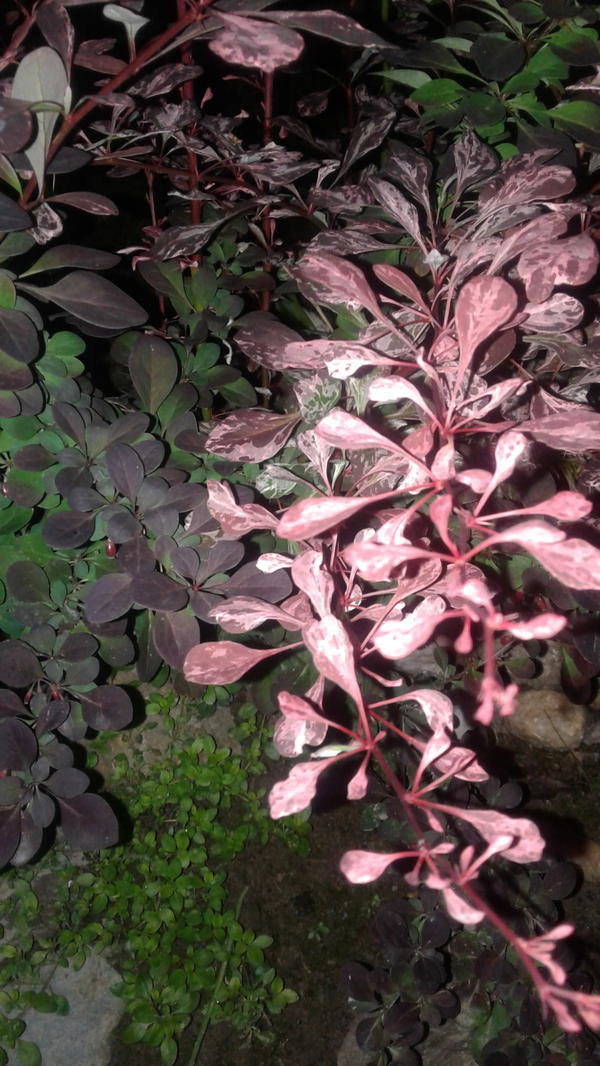
… even at night
With a sunbeam, he strives upward,
As if amber leaves were poured.
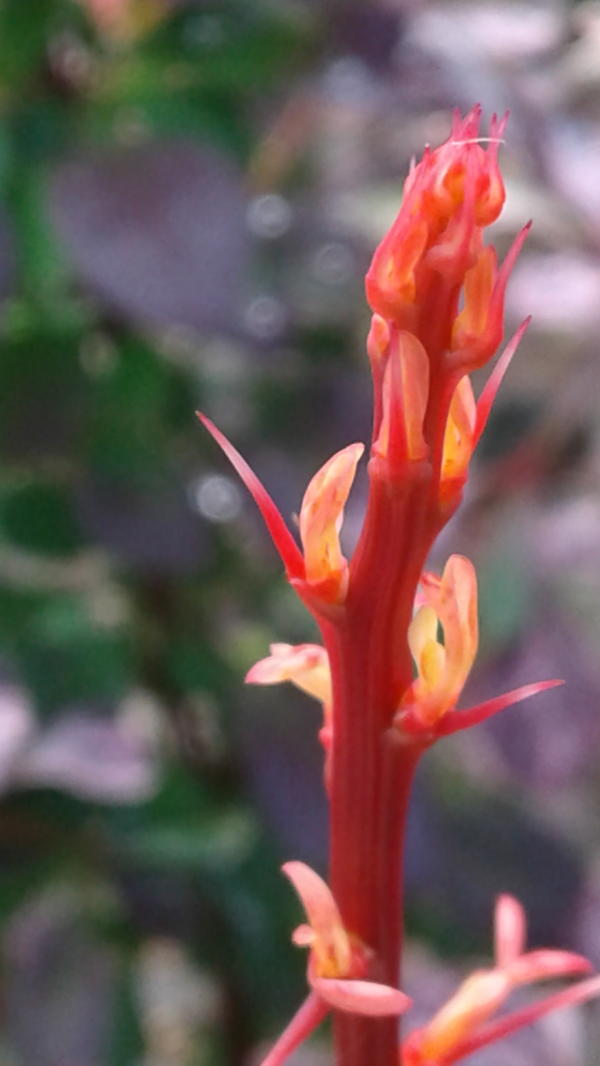
His sheet is an artist, like a living cloud,
Dissolves in the greenery unusual smoke:
Pink, white paint spreading,
Substitutes cheeks under the kiss of rain.
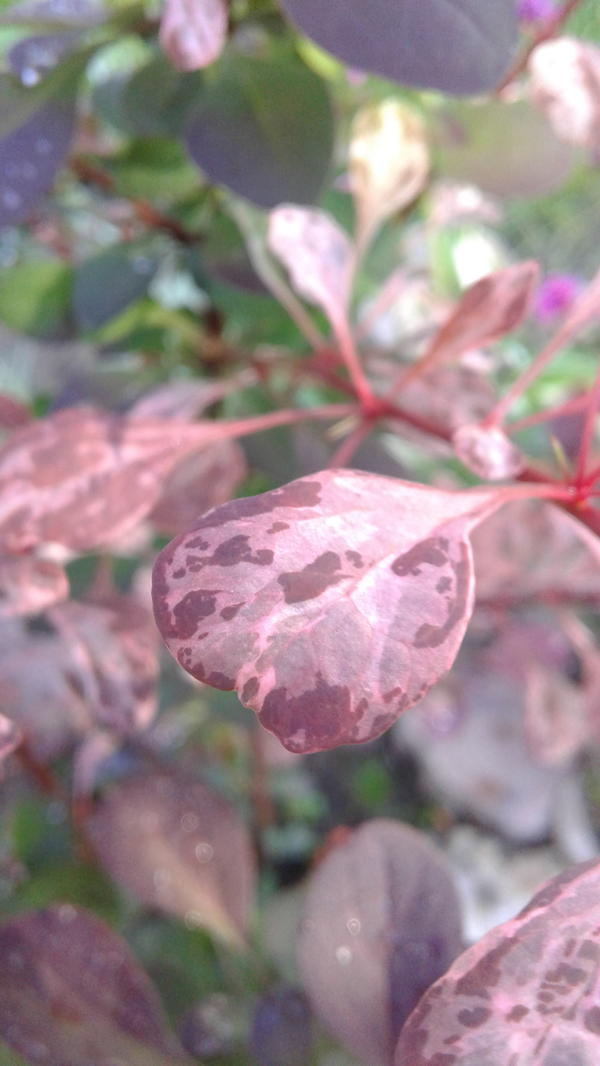
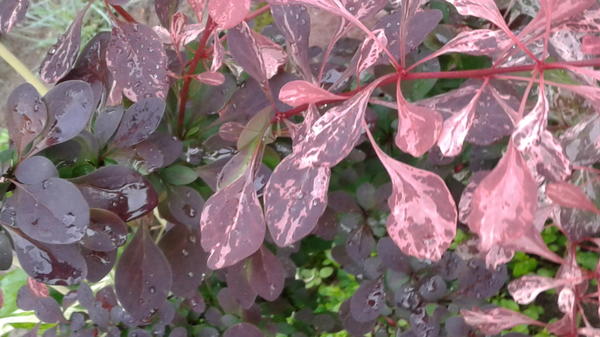
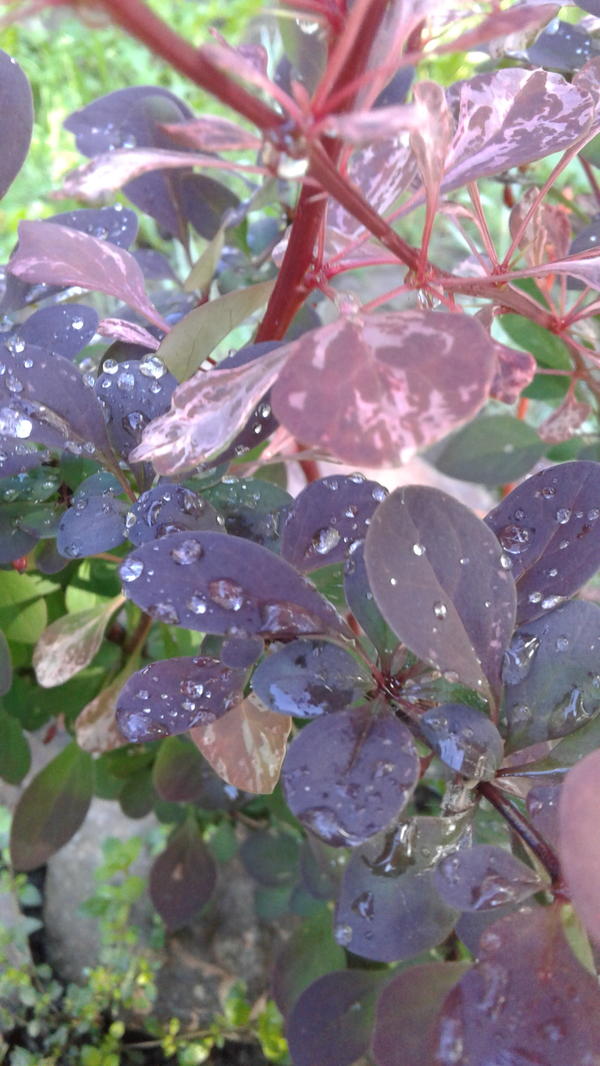
Bumblebee playfully hides in a golden flower,
Hop in the smell early in the dawn.
He collects pollen and nectar he drinks,
Humming flies from flower to flower.
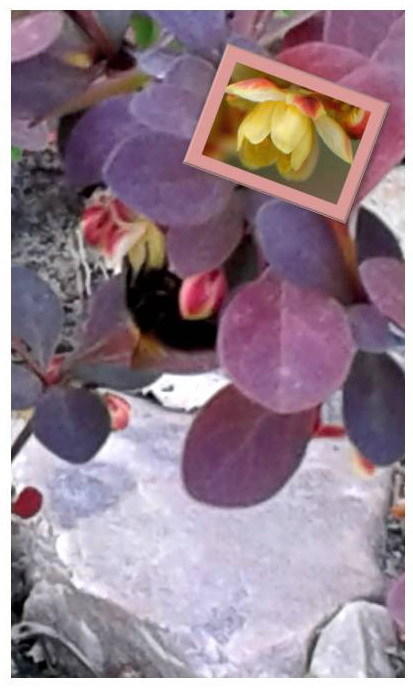
Here wore beads branch in silence,
Shine berries shine that they ripen in September.
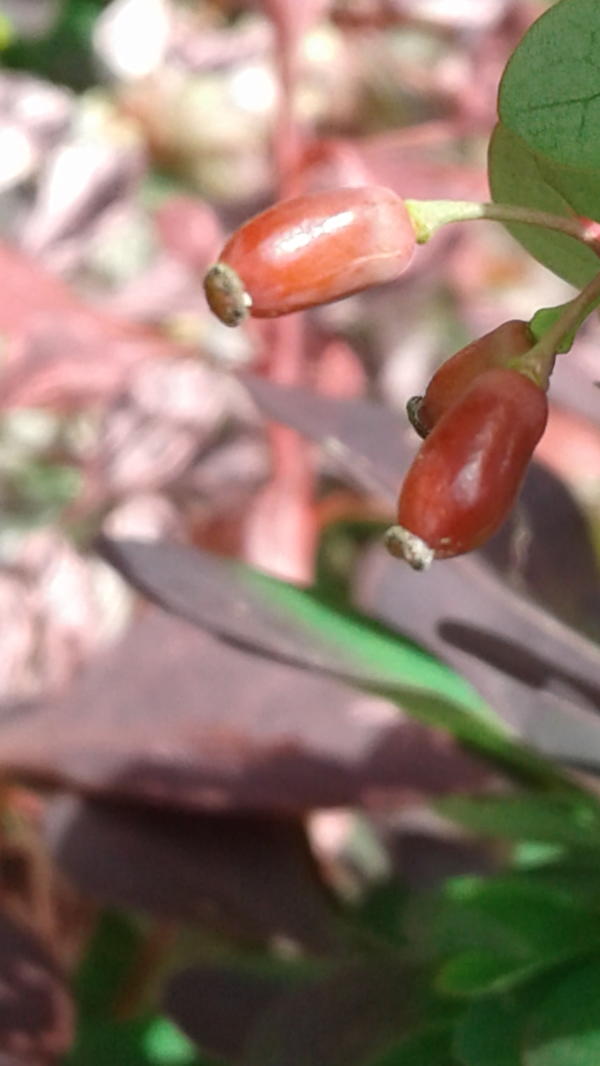
Here is such a handsome man lives,
And let the sadness go or wait.
Very elegant deciduous shrub. Is not it? He is beautiful at any time of the year. In the spring, when the first green is blooming, its curved branches clothe in green-cherry leaves.

...

... he is already handsome
At this time it is especially attractive for insects. Bumblebees and bees willingly flock to the scent of its yellow-red flowers, a scattering of tender bells located throughout the branch. Flowering occurs at the end of May and lasts a little more than a week.
Then, motley leaf color is observed, which is marked by the beginning of the growth of annual shoots.
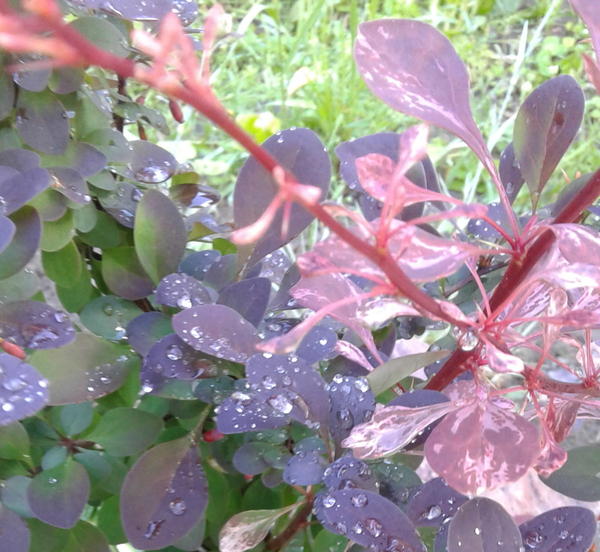
At this time, the bush looks particularly elegant, as the green branches sprinkle bright, sun-drenched, oblong berries, which in winter will be an excellent vitamin supplement to the bird's diet. For us, unfortunately, the berries of the barberry Thunberg are not edible, as they have a bitter taste. And the feathered brothers readily enjoy the purple, glossy small berries from the pink fountain.

The fruits ripen in September.
The bush has thorns - it is modified leaves, about 1 centimeter long.
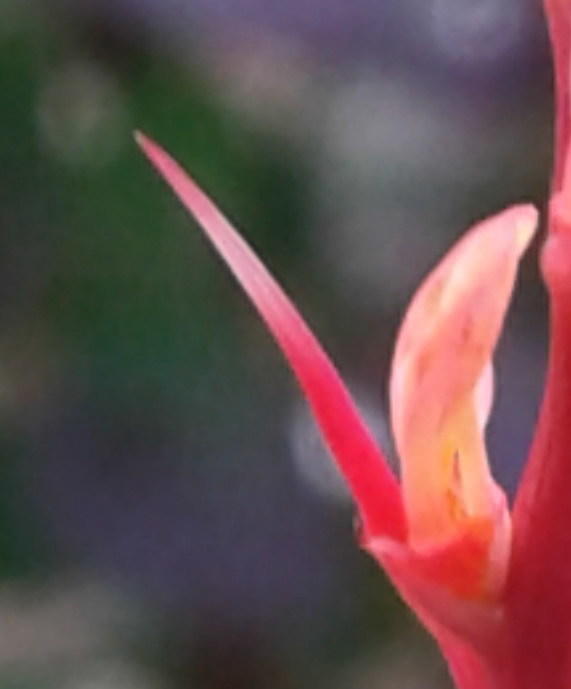
In adulthood, the shrub will reach no more than 1.5 meters in height. The soil is not demanding, frost resistant. The winter of this year, my young still barberry survived without any additional shelters. But still recommend young bushes to cover for the winter with fallen dry leaves or spruce branches. It loves sunlit places, although it tolerates light partial shade, it is drought-resistant. To maintain youth and beauty it is necessary to carry out pruning. Performs the role of a bright, rich color accent and is a true decoration of the garden, gives a festive mood.
Give yourself a festive mood as well by planting barberries at your dacha Thunberg "Rose Glou"
Best regards and wishes have a nice day, your Tatiana.
The record is posted in sections:
|
|
Barberry Toonberg Rose Glow
Berberis Thunbergii Rose Glow
The form:Deciduous, loose shrub with a well-branched crown, spreading shape, height of 1.5-2 m. The main branches are vertical, lateral shoots are widely declined. The shrub has sharp thorns and original leaves. The original color of leaves in purple with white and gray specks highlights the barberry Rose Glow among many other plants and makes it one of the most popular and desirable barberries in private collections and gardens.
The size:height and width of 1.5-2 m.
Shoots: red, later dark red, faceted, with single spikes, like all barbarians of the tunberg. Early spring sanitary pruning of old shoots.
Leaves: leaf shape - alternate, ovate. Barberry tunberg every spring Rose glow breaks into the new season with its colorful outfit of purple leaves with white and gray specks and this colorful show lasts throughout the growing season. At the end of autumn acquires new bright red, orange and golden colors.
Type of flowers:simple, yellow flowers that hide among the leaves in the middle of spring, after which they decorate the barberry with bright red fruits that hang on the bare twigs all winter.
Flowering time:in May yellow flowers, collected in inflorescences of several pieces.
Fruit:coral-red, elliptical, up to 1 cm in diameter, ripen in September-October and last until winter.
Roots: well-branched surface root system, but the individual roots are deep, with a large number of thin roots.
Light Attitude / Insolation:light-requiring, but tolerates a slight shading.
Humidity:moderately moist soil.
Type of soil: acidic or slightly alkaline soil, prefers fresh places, undemanding, drought and heat resistant.
Pests: the most dangerous barberry aphid, in a matter of days, it can turn the pretty leaves into withered compressed lumps. To protect the bushes from this pest, in the spring spend preventive spraying with insecticides. The specialist will be able to determine the pest in order to choose the right methods and means of controlling and protecting the plant. Preventive treatments with fungicides are desirable. Prevention and treatment - In the spring and again in the summer spraying with insecticides (Aktara, Enzio, Aktellik, Match). It is better to carry out preventive treatments once a month than to treat them when the pest multiplies and “eats” the plant. An example is the war of gardeners and Ukrainians with Colorado beetles, who, like their human “wadded” namesakes - “Colorado”, are very dangerous and gluttonous. Aktara 1gr 1l watering at the root of 30-100 grams per plant, depending on size.
Landing:barberry seedlings Rose Glow, purchased in the nursery PROXIMA, are provided with prolonged fertilizers with the latest formulas of the best European manufacturers and can be sold in your garden center without additional fertilizing for a whole year. But the greatest advantage of buying plants in a pot is that they can be planted without buying additional fertilizers, from March to December - even on the hottest days of summer.
Application: in stony and alpine hills. Shrubs are planted in different color compositions, it can complement any group and become its accent, due to the unique decoration of the leaves. Use in hedges.
Features / Benefits: Despite the sophistication decorative leavesBarberry Rose Glow is a strong plant: it carries the wind, urban conditions, pollution, temporary drought. It has various applications, it cuts well.
Climate / frost resistance zone: 5a frost-resistant for all territory of Ukraine.
Barberry Toonberg Rose Glow in Kiev can be bought at low prices at the plant nursery PROXIMA.
Read more about planting, watering, care, fertilizer, protection - with a photo in the "Planting, care" section.

